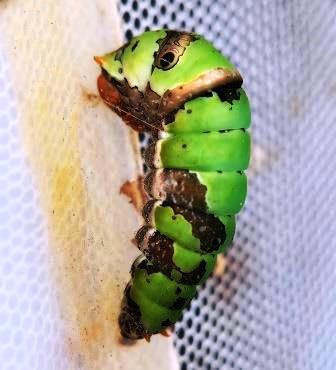Family. Papilionidae.
Order. Lepidoptera.
Common name. Lime swallowtail, kupu-kupu jeruk (Indonesia)
Distribution. Papilio demoleus malayanus is native to southern Myanmar and the Malay Peninsula. Its range has expanded into Indonesia, the Philippines, New Guinea, Solomon Islands, Australia, Europe, and the Caribbean.
Host plants. P. d. malayanus feeds on plants in the Citrus genus of the Rutaceae family. It feeds on Citrus hystrix DC, Citrus aurantifolia Swingle, Citrus amblyocarpa Ochse, Citrus grandis Osbeck, Citrus×microcarpa (Bunge) Wijnands, and Citrus maxima (Brum.) Merr.
Description and biology. Adult butterflies have a striking pattern with yellow coloring on their body and yellow and black markings on their wings (Figure 1). Their hind wings lack a tail-like projection and feature a brick-red oval spot on the upper margin and a blue spot near the lower margin. The wingspan of these butterflies is between 80 to 100 mm.
 |
| Figure 1. The lime swallowtail, Papilio demoleus malayanus (Photo:© Aunu Rauf} |
The eggs of this particular species measure between 1.0 to 1.5 mm in diameter. They are spherical in shape, have a smooth surface, and are pale yellow in color (Figure 2). The eggs are laid individually on the surface of young leaves and twigs. It takes around 3 to 5 days for the eggs to hatch.
 |
| Figure 2. Egg of Papilio demoleus malayanus on the surface of young leaf (Photo: © Aunu Rauf) |
When they are young, the larvae appear blackish-brown with conspicuous milky-white markings and bumps. They look similar to bird droppings (Figure 3).
 |
| Figure 3. Young larva of Papilio demoleus malayanus on lime leaf (Photo: © Aunu Rauf) |
When fully grown, the larvae are about 3-4 cm in length. They are a rich, brilliant green color that is both smooth and velvety, lacking any tubercles. Dusky bronze oblique bands are visible on the lateral abdominal segments. These bands do not meet on the dorsum (Figure 4). The total duration of the larval stage ranges from 11 to 16 days.
 |
| Figure 4. Full grown larva of Papilio demoleus malayanus on lime leaf (Photo: © Aunu Rauf) |
As the larva reaches the end of its fifth instar, its body becomes shorter and it eventually stops moving. It then uses silk to hang itself from a twig or other object and enters the prepupal stage (Figure 5). This stage lasts for approximately 1 day on average.
 |
| Figure 5. Prepupa of Papilio demoleus malayanus (Photo: © Aunu Rauf) |
During the pupation stage, the insect transforms into a chrysalis that attaches to the underside of twigs. The chrysalis is supported by a thin silken thread (Figure 6). Initially, the chrysalis is mostly green and turns straw to brown before the adult insect emerges. The pupal period lasts for 8-12 days.
 |
| Figure 6. Pupa of Papilio demoleus malayanus attached on a twig (Photo: © Aunu Rauf) |
Nature of damage. Larvae feed on the foliage of citrus trees. The species can be a serious pest of young citrus trees and cause damage in nurseries but is usually considered a minor pest of mature trees.
Natural enemies. According to Matsumoto's 1996 report, parasitoids Brachymeria sp. and Eulophidae emerged from pupae of P. d. malayanus collected from larvae in Bogor.
Remarks. Lime swallowtail (Papilio demoleus malayanus) is the most common butterfly attacking citrus saplings in urban habitats in Bogor.
Guerrero KA, Veloz D, Boyce SL, Farrell BD. 2004. First new world documentation of an old word citrus pest, the lime swallowtail Papilio demoleus (Lepidoptera: Papilionidae), in the Dominican Republic (Hispaniola). American Entomologist 50(4): 227-229.
Kato S. 1989. Notes on Papilio demoleus L. collected in Java, Indonesia (Lepidoptera Papilionidae). Tyo to Ga 40: 189-191.
Lambkin TA. 2017. Papilio demoleus malayanus Wallace, 1865 (Lepidoptera: Papilionidae) on Dauan Isand, Torres Strait, Queensland and recent confirmation of P. d. sthenelinus Rotschild, 1895 in the Lesser Sunda Islands. Australian Entomologist 44(2): 65-74.
Matsumoto K. 1996. Establishment of Papilio demoleus L. (Papilionidae) in Java. J Lep. Soc.50(2): 139-140.
Moonen JJM.1991. Papilio demoleus L. in Java (Lep.: Papilionidae). Tyo to Ga 42(2): 93-94.
Moonen JJM. 1998. Notes on some Papilionidae Lepidoptera) from Indonesia. Trans. Lepid. Soc. Japan 49(3): 219-228.
Morgun DV, Wiemers M. 2012. First record of the lime swallowtail Papilio demoleus Linnaeus, 1758 (Lepidoptera, Papilionidae) in Europe. J Res Lepid 45: 85-89.
Citation: https://indoagriinsecta.blogspot.com/2024/02/papilio-demoleus-malayanus.html
No comments:
Post a Comment